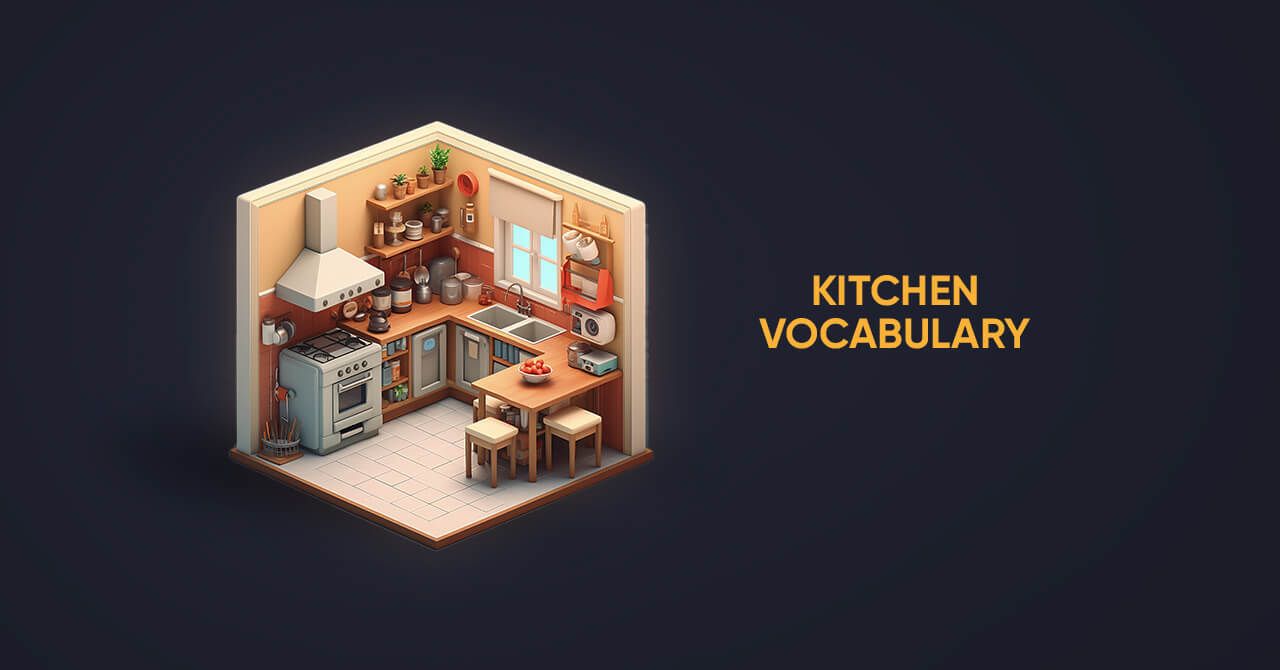
101 Kitchen Vocabulary Words in English and How to Learn Them
Learning English kitchen vocabulary can be a rewarding yet challenging process. With frequent exposure and consistent practice, you will be cooking up a storm in no time.
We all need to eat, so knowing the basics of food and kitchen vocabulary is vital when learning English. Whether you want to order food in a restaurant, become a professional chef, or just make small talk about food and cooking, you’re going to need some fundamental kitchen verbs and nouns.
How to learn kitchen vocabulary
Before we proceed with the engaging list of new words and phrases, we’d like to add some advice on how to learn these new words.
Practice speaking
One of the best ways to learn new vocabulary is by speaking out loud. Even if you don’t have anyone to speak to, you can talk to yourself! Narrate what you’re doing as you cook to practice using the words you have learned in the proper context.
Recipe writing
If you prefer writing, you can write your own recipes or keep a journal to note down what you have been up to in the kitchen, using, of course, all of your new cooking terminologies. Don’t forget to list the cooking equipment and utensils.
LiveXP’s Word Trainer
The most effective way to memorize new words, master the pronunciation, and correctly use them in context is with the Word Trainer feature of LiveXP. The LiveXP app for language learning helps you practice kitchen words, including those you come across during your LiveXP lessons with an English tutor, by adding them to the Word Trainer. The frequency of word repetition is tailored to your progress, which helps you remember more words for longer. You just need to add new vocabulary, and the system will remind you when to practice them for the most efficiency.
Watch TV
Watch cooking channels on TV, such as The Food Network. Mainstream television channels show many kinds of cooking and baking shows, teaching you recipes to make at home, and competitions, where amateur or professional chefs and bakers fight it out to become the champion of the series. For example, The Great British Baking Show, originally The Great British Bake Off, and MasterChef.
Take English lessons
An English tutor doesn’t just teach boring grammar! You can enlist the help of a teacher to expand your culinary lexicon or simply to practice chatting in English with a native speaker. 1-on-1 lessons on LiveXP enable you to have culinary-themed conversations with a tutor who shares the same interests as you and adores cooking.
Take a cookery class
If you feel confident with the basics of English and are starting to learn kitchen vocabulary, then you could sign up for an English cookery class. If you don’t live in an English-speaking country, why not do an online course? This can help you put your knowledge into practice and learn more vocabulary in the process.
Use social media
Social media is a great way to learn language vocabulary in the 21st century. When it comes to kitchen jargon, there are millions of videos online to help you learn. Follow chefs, amateur cooks, or bakers on Instagram, TikTok, Snapchat, Facebook, or any other social media app and regularly look at their content. The best accounts to follow are the ones with content creators who film tutorials that they speak aloud so that you can hear the kitchen vocabulary in context.
Label your kitchen
There’s no better place to start than your home, so make sure you’re putting your English into practice at every opportunity. Why not say the name of food as you put away your groceries or say the name of every utensil you see or touch? If you don’t know a word, label it or write the name on it with a permanent marker.
Top tips for learning new words
Group words by themes
As we have done in this article, you should try to memorize words that are related to form mental connections between them.
Use context clues
When encountering new terminology, for example, in recipes, try to infer the meaning from the context before looking up a word in the dictionary or online. This will improve your ability to guess meanings and enhance your comprehension skills.
Be consistent
Last but not least, consistency is key. Stay motivated by setting achievable goals and tracking your progress, and practice on a regular basis.
Learning English kitchen vocabulary can be a rewarding yet challenging process. With frequent exposure and consistent practice, you will be cooking up a storm in no time.
Kitchen vocabulary words: appliances
First, you need to know your way around a kitchen, starting with the appliances.
- Oven: An enclosed area to cook and heat food
- Stove: An apparatus for cooking or heating that operates by burning fuel or using electricity. Nowadays, the stove usually has either induction plates or gas burners.
- Stovetop: The part of a stove where the pans are placed; it can be called a cooktop in the US, and a hob in Britain.
- Microwave oven: this apparatus uses electromagnetic waves called microwaves to cook or heat food.
- Refrigerator: Also known as a “fridge” in British English, this is where we keep food cold.
- Freezer: Freezers can be part of a fridge or completely separate, and they are where we store frozen food and ice.
- Sink: We wash dishes, vegetables, and our hands in the sink. Water comes out of a faucet or tap, and we place clean dishes on a draining board to dry.
- Dishwasher: If you have a dishwasher, you won’t need to hand-wash your dishes, as this machine does it all for you.
- Countertop: Also called a worktop, this is the flat space on top of lower cabinets where you can prepare food.
- Cupboards: Kitchen cupboards store food, utensils, and other items. They have a door that opens, and drawers are pulled out towards the front so that you can see everything inside.
Kitchen words in English
Once you know your way around the room, you can start to tackle the English words for cookware. Cookware is the name for things in which we cook our food. To begin, the items that we use to cook on the stove are as follows:
- Saucepan: A deep, round cooking pot with a long handle and a lid used for boiling and simmering.
- Frying pan: A shallow, flat-bottomed pan with a long handle used for frying and sautéing.
- Wok: A deep, round-bottomed cooking pan with sloping sides, used mainly for stir-frying.
In the oven, you would use the following:
- Roasting pan: A large, rectangular pan with low sides used for roasting meats and vegetables.
- Baking tray: A flat, rectangular sheet used for baking cookies, pastries, and other items.
Be sure to use recipients that can safely be heated to a high temperature and are suitable for use in the oven; we can describe these as ovenproof.
Kitchen vocab: Tableware
When you’re ready to serve the food, you will need tableware. We use tableware to eat and drink at the table.
- Knife: A utensil with a sharp blade used for cutting or spreading food.
- Fork: A utensil with prongs used for piercing and bringing it to your mouth.
- Plate: Flat dishes for serving food.
- Bowl: A round dish for serving food, particularly liquids such as soup.
- Cutlery: Utensils for eating and serving food.
- Tablespoon: A large spoon used for serving or measuring food, also called a serving spoon.
- Teaspoon: A small spoon used for stirring, serving, or measuring small amounts of food.
- Soup spoons: Spoons with a round bowl for eating soup.
- Dessert spoons: Medium-sized spoons for eating desserts.
There are many types of knives, forks, and spoons, but unless you’re planning on having a formal banquet or inviting the King and Queen for dinner, you shouldn’t worry about all of the different kinds.
Words related to kitchen: Verbs
One of the hardest parts of learning to cook in a foreign language is knowing the correct verbs. Cooking verbs are very specific and generally aren’t taught to students learning English as a foreign language.
Cooking verbs
- To cook: The umbrella term which means preparing food by applying heat, using any one of the following techniques…
- To bake: Cooking food thanks to dry heat in an oven.
- To roast: To cook food by prolonged exposure to heat in an oven, such as roasting chicken.
- To toast: Browning or cooking food by exposing it to a grill or other source of radiant heat.
- To fry: Cooking food in hot fat or oil, typically in a shallow pan
- Stir fry: The clue is in the name, as this means frying food while stirring.
- Deep fry: This entails submerging food in hot oil. Fried chicken and French fries are deep-fried foods.
- To sauté: this French term means to cook quickly in a small amount of oil or fat over medium-high heat.
- To grill: To cook food on a gridiron over direct heat, usually with a barbecue. Note that in many English-speaking countries, a grill refers to a device that radiates heat downwards for cooking food.
- To poach: To cook gently in simmering liquid, typically water, such as a poached egg.
- To boil: Cooking food by submerging it in water at its boiling point, 100°C or 212°F.
- To steam: To cook food using the steam from boiling water.
- To simmer: Heating to just below boiling point, where small bubbles form slowly.
Food preparation verbs
- To mix: Combine ingredients.
- To pour: Transfer liquid from one recipient to another.
- To stir: Mix with a spoon.
- To wash: Clean with water.
- To peel: Remove the outer skin, either with your hands for many fruits or with a peeler for most vegetables.
- To chop: Cut into pieces.
- To cut: Divide with a knife.
- To dice: Cut into small cubes.
- To slice: Cut into thin pieces.
- To grind: Crush into powder or small pieces.
- To grate: Shred into small pieces.
- To combine: Mix ingredients together.
- To marinate: Soak in a sauce to add flavor.
- To whisk/beat: Mix quickly with a hand whisk or electric whisk.
- To blend: Mix thoroughly.
- To crack/break: Open by force.
- To layer: Arrange one layer of food on top of another several times.
- To preheat: Turn the oven on and allow it to reach the desired temperature before using it.
- To add: To put one ingredient into the preparation, uniting it with the other ingredients.
- To melt: To liquify something using heat, such as chocolate or cheese in fondue.
- Drain: To remove water from food, often with a colander, when it is cooked, such as pasta.
- To season: To add flavor to your food, usually with salt and pepper, but also with herbs and spices.
- To squeeze: To force a liquid out of something by pressing it firmly; for example, squeeze a lemon.
- Knead: To work moistened flour into dough or paste with your hands.
- Roll out: To flatten by rolling a rounded object over something; for example, roll out the pastry before cutting it into circles.
Kitchen tools in English
- Mixing bowl: A large bowl used for mixing foods together when cooking.
- Colander: a metal or plastic bowl with a lot of small holes in it, used for draining water from food after washing or cooking.
- Sieve: a device for separating lumps from powdered material or straining liquid, for example, “sieve the flour to remove lumps.”
- Spatula: This tool with a wide, flat blade is used for lifting or flipping food in a pan, but it can also refer to the utensil used for spreading food or scraping the remnants out of a bowl.
- Tongs: A tool with two long pieces joined at one end, used to grip and lift food.
- Ladle: A large, deep spoon used to serve liquid foods such as soup or stew.
- Apron: A garment worn to protect clothing while cooking.
Food vocabulary
While it would be impossible to list all of the food items in English, we’re going to give you the keywords that you need to know. We’ll start with the food categories and then list some essential terms within each category.
Fruit and vegetables
The first and simplest food group is fruit and vegetables. Many nutrition guides recommend that vegetables take up the most space on your plates during meals. We also talk about “eating your five a day.” This expression encourages people, especially children, to consume five portions of fruit or vegetables every day.
Examples:
- Apples
- Oranges
- Bananas
- Carrots
- Peas
Dairy
Dairy is another term for milk products. Dairy comes from animal milk, usually cow’s, but can also include sheep’s milk, goat’s milk, and more. Nowadays, we can also include dairy-free milk alternatives in this category.
- Butter
- Cheese
- Cream
- Ghee
- Yogurt
Protein
Protein is a molecule made up of amino acids. Protein-rich foods are needed for the body to function properly. Animal products such as meat and fish are the main sources of protein, although legumes such as beans and lentils are also protein-rich.
- Chicken
- Turkey
- Pork
- Shrimp
- Eggs
Grains (carbohydrates)
The grains category encompasses all foods made from wheat, rice, oats, cornmeal, barley, or any other cereal grain. These foods are called starchy. They are our main source of carbohydrates and have an important role in a healthy diet. Due to their high starch content, potatoes are often grouped together with grains despite being a vegetable, botanically speaking.
- Bread
- Pasta
- Rice
- Porridge
Fats and sugars
Finally, fats and sugars are the food groups that we should consume the least of as part of a healthy diet. Fats and oils store energy, keep people warm, and protect organs like the heart and lungs, but generally speaking, fats and sugars are high in calories but lack nutritional value.
Examples of fats:
- Butter
- Margarine
- Salad dressing
- Cooking oils
Examples of sugars:
- Chocolate
- Cakes
- Candy
- Fizzy drinks
Hello! My name is Beth. I'm from France. I'm a French and English native speaker and I really like writing.

